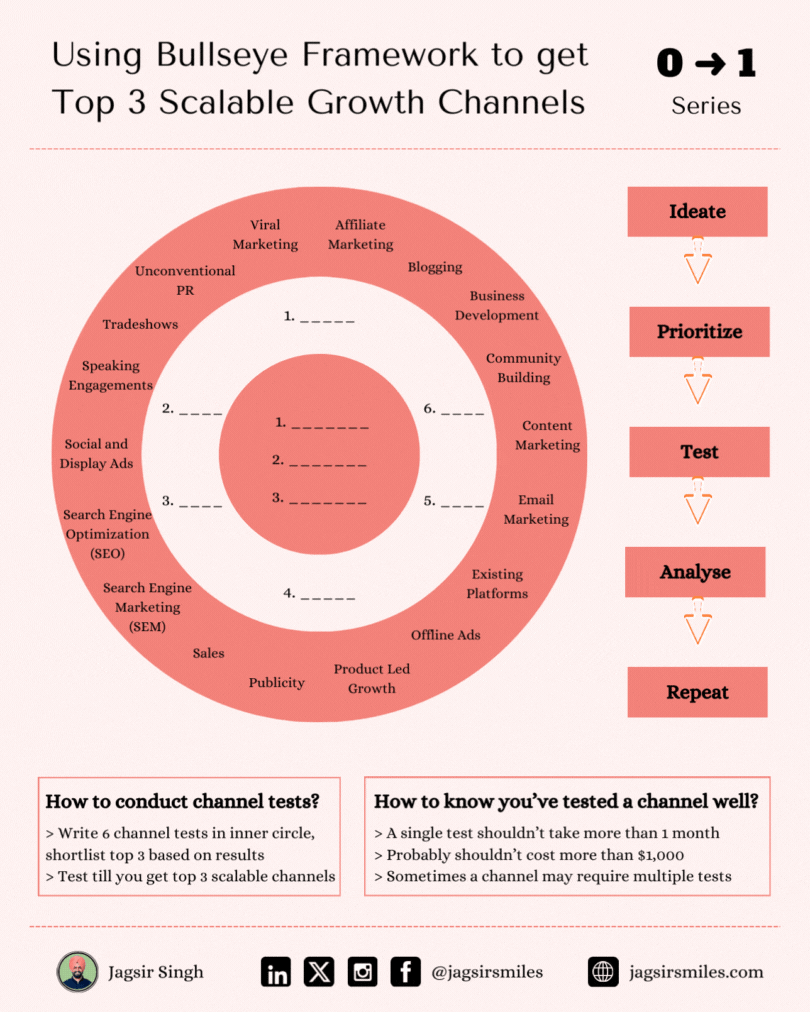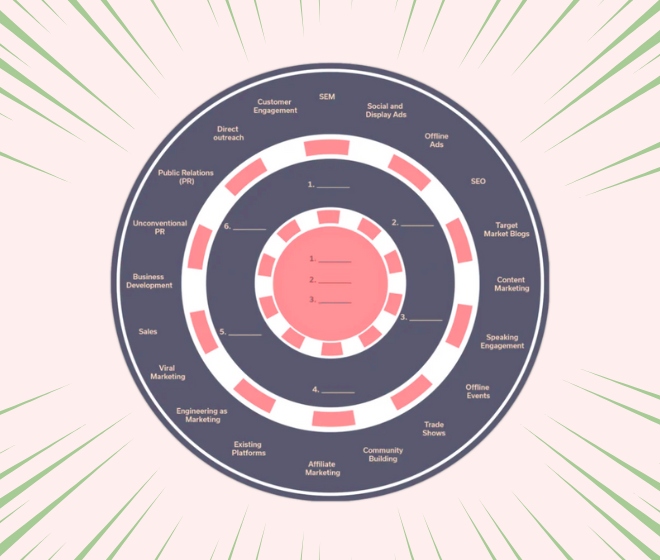In the dynamic world of startups, focusing your energy on the right things can mean the difference between explosive growth and stagnation. The common “spray and pray” approach—where you try a little bit of everything—often leads to wasted resources and a lot of frustration. The good news is, there’s a proven, systematic way to find your most effective growth channels. It’s called the Bullseye Framework.
Developed by Gabriel Weinberg and Justin Mares in their book, Traction, the Bullseye Framework is a powerful roadmap. It guides you to a clear, data-driven strategy to identify and scale your top three growth channels, ensuring every action you take drives real results.
Key Takeaways from the Bullseye Framework
- Focus is Freedom: The Bullseye Framework helps you move from chaos to clarity by forcing you to prioritize your efforts and resources on what truly works.
- Proof Over Guesses: This methodology is built on a foundation of data-driven experiments, ensuring you make strategic decisions based on evidence, not assumptions.
- Efficiency Drives Impact: By identifying your most scalable channels, you can maximize your ROI, ensuring every dollar and every hour you invest creates a significant impact.
- Adaptability is Key: The Bullseye Framework is not a one-time process; it’s a continuous cycle that allows you to adapt your strategy as your business and market evolve.
The Power of Focused Action
The “spray and pray” mindset is a common founder trap. You see your competitors using a certain channel and you think, “that’s our silver bullet.” You read some guru’s blog post and you’re convinced that a specific channel is the future of marketing. This scattered approach creates a false sense of progress but produces zero results. You can’t afford this. You can’t outspend your competitors, so you have to outsmart them.
This is where the Bullseye Framework becomes your greatest asset. It provides a clear, logical path to scalable growth. The framework outlines 19 potential growth channels and guides you through a process of testing, shortlisting, and focusing on the three that will drive your business forward. This systematic approach allows you to be deliberate and data-driven with your marketing, rather than relying on intuition or what’s “hot.”

The 19 Bullseye Framework Channels
To effectively use the Bullseye Framework, you must first understand the landscape of all possible channels. Below is a comprehensive list of all 19 channels, along with their relevance to different business models and their scalability potential.
| Channel | Description | Relevant for | Scalability vs. Cost |
| 1. Viral Marketing | Encourages users to spread your product to others. | B2C, B2B, D2C | High scalability, low cost (if it works) |
| 2. Public Relations | Generates earned media coverage to create a buzz. | B2B, B2C, D2C | Medium scalability, medium cost |
| 3. Unconventional PR | Uses creative, shocking, or unique stunts to get media attention. | B2B, B2C, D2C | High scalability, low cost |
| 4. Search Engine Marketing | Places ads on search engines based on keywords. | B2B, B2C, D2C | High scalability, high cost |
| 5. Social & Display Ads | Runs targeted ads on social media platforms and websites. | B2B, B2C, D2C | High scalability, high cost |
| 6. Offline Ads | Traditional advertising via radio, print, billboards, etc. | B2C, D2C | Low scalability, high cost |
| 7. Search Engine Optimization (SEO) | Optimizes your website to rank higher in organic search results. | B2B, B2C, D2C | Medium scalability, low cost (time intensive) |
| 8. Content Marketing | Creates and distributes valuable content to attract and engage a target audience. | B2B, B2C, D2C | Medium scalability, medium cost |
| 9. Email Marketing | Builds relationships and drives conversions through email. | B2B, B2C, D2C | Medium scalability, low cost |
| 10. Engineering as Marketing | Builds free tools or resources that market your product. | B2B, D2C | High scalability, low cost |
| 11. Target & Community | Engages directly with a niche audience in online forums and communities. | B2B, B2C | Low scalability, low cost |
| 12. Offline Events | Hosts meetups, workshops, or parties to engage potential customers. | B2B, B2C | Low scalability, medium cost |
| 13. Speaking Engagements | Shares expertise at conferences and events to build credibility. | B2B | Low scalability, low cost |
| 14. Affiliate Programs | Partner with others to drive sales in exchange for a commission. | B2C, D2C | High scalability, low cost |
| 15. Existing Platforms | Leverages established platforms like the App Store or YouTube. | B2B, B2C, D2C | High scalability, low cost |
| 16. Trade Shows | Exhibits at industry-specific trade shows to meet potential customers. | B2B | Low scalability, high cost |
| 17. Sales | Engages directly with customers through a sales team. | B2B, D2C | High scalability, medium cost |
| 18. Business Development | Forms strategic partnerships to grow the business. | B2B | Medium scalability, medium cost |
| 19. Direct Sales | Engages directly with customers through a sales team. | B2B, D2C | High scalability, medium cost |
Case Studies of Successful Bullseye Framework Implementation
This isn’t just a theory. It’s a practice that has built billion-dollar companies.
Case Study 1: DuckDuckGo When Gabriel Weinberg and Justin Mares first applied the Bullseye Framework, DuckDuckGo’s growth seemed slow. They brainstormed channels and tested traditional ones like SEO and paid ads, but these were not scaling well enough. Instead, they discovered that public relations and community building were their bullseye channels. They focused on reaching people who were already frustrated with Google and built a product that addressed their privacy concerns. By leveraging their story and building a strong community, they achieved massive, organic growth that competitors couldn’t touch. This case shows how the Bullseye Framework can reveal unconventional, yet highly effective, channels.
Case Study 2: A B2B SaaS Startup Consider a B2B SaaS startup aiming to sell project management software. In their outer ring, they brainstormed 19 channels. For their middle ring, they chose to test content marketing, paid search, and speaking engagements at industry conferences. They quickly learned that while content marketing brought in some organic traffic, it was too slow to scale. Paid search was too expensive to be their primary channel. However, public speaking at industry events brought in high-quality, high-intent leads that converted at a much higher rate. They added speaking engagements to their bullseye. This systematic approach allowed them to focus their limited marketing budget on a single, high-ROI channel.
Case Study 3: A Local Business in Bengaluru Even small businesses in a specific market like Bengaluru, Karnataka, can apply this framework. For a local coffee chain, the outer ring might include local keywords, social media, and local partnerships. Their middle ring could be local SEO, influencer marketing, and sponsoring a community event. They might find that local keywords and community partnerships provide a much higher ROI than generic influencer campaigns. The Bullseye Framework helps them avoid wasting money on campaigns that don’t reach their local audience.
Founder Q&A: Your Top Bullseye Framework Questions Answered
Q: Why can’t I just copy my competitor’s growth channels? A: You will probably fail. What works for them is a result of their specific market, product, and timing. By the time you copy them, the opportunity has likely passed. Your most effective channels can be completely different.
Q: What if none of the channels I test work? A: They will. Your goal isn’t to find a magic bullet; it’s to find a channel that works for your specific business. If the first six experiments fail, you brainstorm six more. This process ensures you’re not making big bets and you’re always learning.
Q: How do I know if a channel is working? A: Data. You need to define clear metrics (ROI) for each experiment and track them rigorously. The framework’s core value lies in allowing for frugal testing before aggressive spending.
Q: Should I ever move on from my three bullseye channels? A: Yes. The market changes. Your product changes. The Bullseye Framework is a continuous process, not a one-time exercise.
The Frugal Founder’s Roadmap to Scalability
The Bullseye Framework is your roadmap to building a marketing machine that actually works. It helps you build a network of partners who can amplify awareness and capture demand. It is a system that guides you through the process of creating a marketing program that produces a steady flow of inbound MQLs and fuels strong pipelines.
The days of guessing are over. The days of “spray and pray” are done. The only way to win is to be data-driven, deliberate, and agile.
Now is the time to take control of your marketing. Build a system that works.


